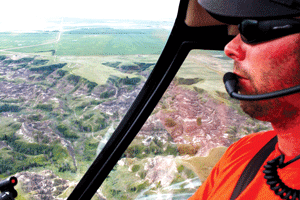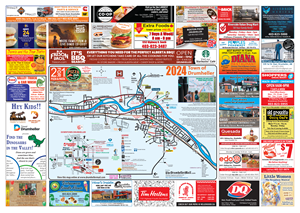
Earlier this week, Mountain View Helicopters gave our summer reporter a chance to see what a tour is like first hand. This is a personal account of the experience.
Having never flown in a helicopter, or any small aircraft for that matter, driving out to Horseshoe Canyon where Mountain View Helicopters (MVH) operates, I wasn’t quite sure what to expect.
It was a clear day on Monday, June 25, a perfect day for flying. Walking up to the Robinson R44, four-seater helicopter for the first time stirred up the butterflies in my stomach.
This is the 10th year of operations for MVH in the Horseshoe Canyon area and the pilots couldn’t be happier.
“It’s a thrill of a life time. A lot of people haven’t been in a helicopter and may have mixed views on the safety of it. I’ll be honest with you, I’d rather be in a helicopter if my engine ever did fail,” said Ryan Fornataro, a licensed visual reference find (VRF) pilot.
This is because a helicopter is much easier to land in an emergency than bigger aircraft, said Fornataro. He also said many people believe that if there is an engine problem it’s game over. That is just not the case at all, because the blades don’t stop when the engine does said Fornataro.
Climbing into the machine, I buckled up and put my headset on, which enables passengers to communicate with each other and the pilot. The engines sounded almost like a lawn mower when fired up, and the blades began spinning so fast you almost couldn’t see them. When everything was warmed up and ready to go, the helicopter began to lift off the ground.
At first, feeling a little nervous, Fornataro assured me there would only be a small amount of that “roller coaster,” feeling when gaining altitude. He was right.
Touring over the Horseshoe Canyon is breathtaking. The canyon walls contrasting with the blooming shrubs and green grass caught the eye. Cars looked like ants marching along Highway 9. The layout of the land were like patches in a quilt, and there was a small body of water in the canyon, as though it was being held in a soup bowl. Streams carved the landscape, woven through in an intricate fashion.
Getting as high as 270 metres in the air, and as low as 150 metres, the flight provided a view from above and some great picture opportunities.
Fornataro made landing the machine look like a piece of cake. Setting it down lightly, it was not a rough experience at all. Overall, the flight was less nerve racking than on a commercial jet.
MVH is a flight school based out of Springbank, Alberta, and by doing these tours they provide their top graduates with a chance to get flying hours.
MVH has also helped with search and rescue missions that have unfortunately occured in the canyon. Chris King, who is also a VRF pilot, said he recalled a hiker with a broken leg needing assistance to get out of the canyon. MVH was right there to help.
Flights range from six to twelve minutes, and there is room for three passengers in the machine, all of who get a window seat. The shorter tour costs $50 for adults, and $40 for children under 12. The longer tour costs $100 for adults and $80 for under 12 years.
Besides tours, MVH is operating a “snack shack" at the canyon beginning this year.
For more information on MVH or tours go to mvheli.com or call (403) 334-4354.








